Sparkling Crystal Clear Fun
Northwest Florida features one of the largest concentrations of natural springs in the Southeast. These seven easily-accessible springs offer great recreational opportunities for the whole family and the adventurous paddler or cave diver. For a complete inventory of Northwest Florida springs, visit nwfwater.com.
Blue Springs Recreational Area
Jackson Blue Spring is the heart of this popular county park, located approximately five miles east of Marianna. Only one of 17 first-magnitude springs in Florida, pumps an average of 85 million gallons of fresh water a day to form Merritt’s Mill Pond. The headwater area is popular for swimming due to the clear water and shallow bowl around the spring vent. Explore the area on a rented paddleboat or kayak. The spring emerges from an underwater cave complex that houses two rare species—the Georgia Blind Salamander and Dougherty Plain Cave Crayfish. Open-water scuba diving and cave diving require proper permits from the county. The Old Spanish Trail passed by Blue Springs and was described many times over the years by Spanish missionaries and officials. The park is open during the summer, from June to September.
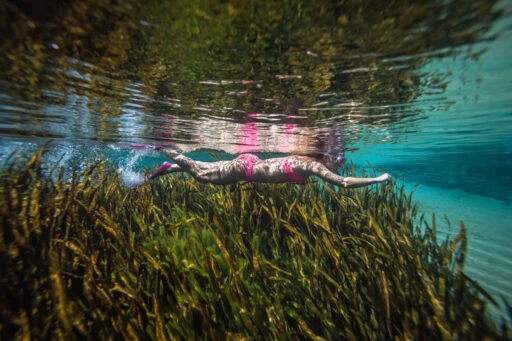
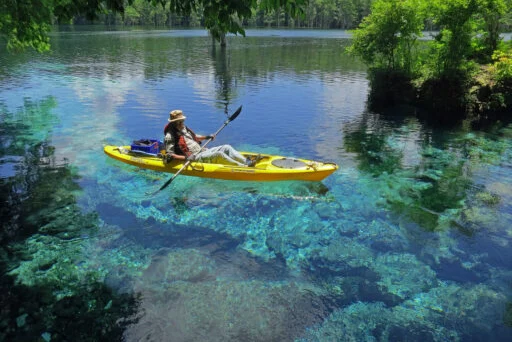
Merritt’s Mill Pond
This unique 202-acre spring-fed pond is filled with crystal clear waters from Jackson Blue Springs and is renowned for its trophy Redear (Shellcracker) fishing. Merritt’s Mill Pond currently holds the state record for Redear at 4.86 pounds and, until recently, held the world record fish. Paddlers, anglers, and cave divers call this a best kept secret. The freshwater is home to great catching, so throw a line out for Largemouth Bass and Bluegill. Certified cave divers travel internationally to explore the caves. Each cave has its own uniqueness, Shangri-la, Twin Caves, Hole-in-the-Wall, Gator Hole, and Indian Washtub caverns. Check out the region’s caves!
Morrison Springs Park
Morrison Springs near Ponce de Leon is one of the most popular swimming, snorkeling, and diving spots in northwest Florida and is well-known throughout the southeast. The large, sandy-bottomed spring is surrounded by a 161- acre park that is managed by Walton County. The spring pumps an average of 48-million gallons of crystal-clear water each day. Specifically, it forms a 250-foot-diameter spring pool and a spring run that flows into the Choctawhatchee River. Surprisingly, 3 cavities are at the bottom of the spring pool, one of which is reportedly 300 feet deep. The natural floodplain setting is also popular for birding, photography, and nature walks. Amenities include a picnic pavilion and restroom facilities. A large wheelchair-accessible boardwalk, with an overlook, links the springs to the floodplain along the spring run.
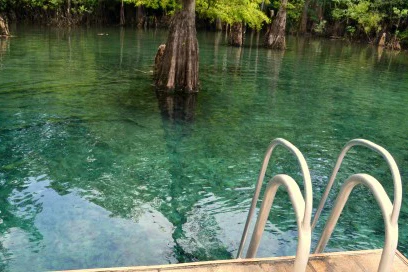
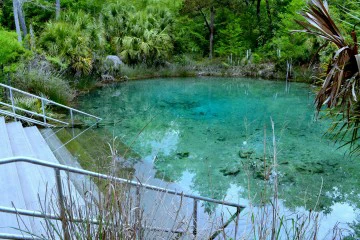
Pitt Springs Recreation Area
Pitt and Sylvan Springs are just two of many springs along Econfina Creek and are among one the most popular. The 10-acre recreation area, managed by the Northwest Florida Water Management District, is in a natural setting of native forest that includes trails and access to other springs. The District recently completed restoration activities and recreational improvements, including an extensive trail and boardwalk system. One of the trails/boardwalks leads from Pitt Spring to the Sylvan Spring area and includes an overlook and a tubing put-in dock. A tubing take-out dock has been constructed at the confluence of Pitt Spring run and Econfina Creek. Swimmers can access the water by stairway. Covered picnic pavilions and restrooms are available in the uplands around Pitt Spring.
Ponce de Leon Springs State Park
This beautiful spring is named for Juan Ponce de León, who led the first Spanish expedition to Florida in 1513, as legend has it, in search of the “fountain of youth.” Visitors might well regain their youth by taking a dip in the cool, clear waters of Ponce de Leon Springs where the water temperature remains a constant 68 degrees Fahrenheit year-round. The main spring is a convergence of two underground water flows and produces 14 million gallons of water daily.
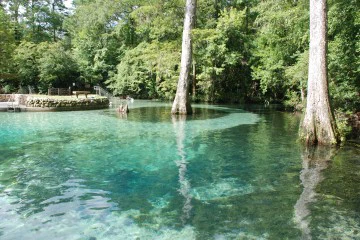
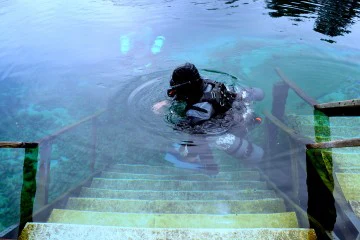
Vortex Spring
Vortex Spring is one of the largest diving facilities in Florida and is a magnet for cave divers worldwide. The spring produces approximately 25 million gallons of crystal-clear water per day at a year-round temperature of 68 degrees. The basin is 50 feet deep at the mouth of the beautiful ledge-like cavern. The room is well lit from surface light. Catfish, harmless Freshwater Eels, Redhorse Suckers, and very rare and exotic “Shadow Bass” are common companions. Located on 360 acres of rolling hills and majestic pines, the facility offers a dive shop, lighted campgrounds, picnic tables, grills, water, electricity, R. V. dump stations, bathrooms with showers, and a 75-foot long “Pinewood Lodge,” with air-conditioned rooms, showers, and kitchenettes overlooking Otter Creek. Visit vortexspring.com.
Cypress Springs
With its second-magnitude strong current, lush banks and deep sapphire waters, Cypress Springs is considered one of the most beautiful springs in Northwest Florida. The spring is one of 51 springs located in the Holmes Creek basin and is a popular destination on summer weekends with boaters, canoeists and kayakers, as well as swimmers, all vying for space in the crystal-clear pool. Because the land surrounding the spring is private property, the sole public access is by traveling up the spring run from Holmes Creek.

